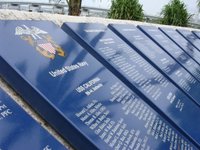In March 04, I was in Hawaii for a series of official meetings and had the opportunity to visit the very poignant Pearl Harbor. I remember that while my colleagues went crazy shopping for Gap, Banana Republic and A&F at Ala Moana Mall, I took a bus to the very popular tourist attraction that brought America into WWII, alone. As I stood in the USS Arizona Memorial, which was built on-top of the sunken behemoth still underwater, and gazed at the tablet that held the names of the thousands who perished, I had this sudden feeling of sadness and melancholy. Although it was crowded on the platform, nobody made a sound. There was this hushed silence of respect and regret.

From the ferry

Inside the Memorial

Those who perished
7 Dec 1941, at five minutes to eight o'clock, 183 Japanese warplanes ruined a perfectly fine Sunday morning on the island of Oahu in Hawaii. The base was not at a state of high alert. Many people were just waking when the first bombs were dropped. No one was prepared to do battle. Japanese aircraft had flown 230 miles from the north, originating from an attack force comprising six aircraft carriers and 423 planes.
The assault was the complete surprise the Japanese wanted, even though at 7:02 a.m., almost an hour before the first wave of planes arrived, two Army radar men on Oahu's northern shore had detected the attack approaching. They contacted a junior officer, who disregarded their reports, assuming they had instead spotted American B-17 bombers expected in from the West Coast of the U.S.
The first wave of Japanese planes, made up of 51 Val dive bombers, 50 high level bombers, 43 Zero fighters and 40 Kate torpedo bombers, attacked when flight commander Mitsuo Fuchida gave the now infamous battle cry "Tora! Tora! Tora!" (Tiger! Tiger! Tiger!) The second wave arrived shortly thereafter.
Pearl Harbor, on the southern coast of Oahu, housed the bulk of the Pacific Fleet at the time of the attack. Less than two hours later, 2,280 American servicemen and 68 civilians were dead, 1,109 were wounded, eight battleships were damaged and five sunk. Three light cruisers, three destroyers, and three smaller boats were lost, along with 188 aircraft.
The biggest loss that day was the USS Arizona, on which 1,177 crewmen were killed when a 1,760 pound bomb smashed through her decks and ignited her forward ammo magazine causing a terrible explosion. Fewer than nine minutes later she was underwater.
Pearl Harbor was the principal but not sole target of the Japanese attack that day. Other military installations on Oahu were hit. Hickam, Wheeler, and Bellows airfields, Ewa Marine Corps Air Station, Kaneohe Bay Naval Air Station, and Schofield Barracks suffered varying degrees of damage, with hundreds of planes destroyed on the ground and hundreds of men killed or wounded.
I also visited Hickam airfield where the bullet holes from the Japanese planes could still be seen peppered on the walls of some of the hangers and buildings, purposely left there as a reminder of that fateful day.